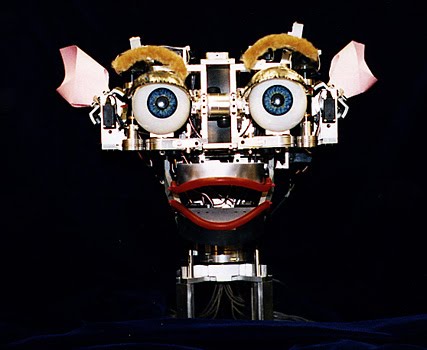
Scientific American reports that a project known as Robot Companions, “which will develop soft-bodied ‛perceptive’ robots as companions for the lonely,” has been selected as a finalist for an EU competition that will award one billion Euros (1.4 billion US dollars) over ten years to
two huge flagship projects that will apply information and communication technologies to social problems. The Future and Emerging Technologies (FET) Flagships aim to unite Europe’s scattered academic forces around well-defined missions that feed directly into the European Union’s social or political goals. “They are like ‛moon-landing’ projects,” says Henry Markram, a neuroscientist at the EPFL in Lausanne, Switzerland…
 Kismet, a “social” robot.
Kismet, a “social” robot.Who knew it was one of the EU’s social and political goals to deal with the problem of loneliness? But if one is so bold as to try to solve for good what might otherwise seem to be a way of human being-in-the-world as perennial as sadness itself, then is a “smart” stuffed animal really the way to go? Of course, people can find emotional solace and support in nearly anything, as readers of Peanuts know full well. But I figure there are essentially two possibilities here. One is that our lonely subject is sufficiently disturbed to be fooled into thinking his soft-bodied companion really is a companion — that it really cares for him and needs his care for its own emotional and physical wellbeing. In that case, Europeans would be spending over a billion dollars to encourage delusions — probably not for the first time.The second possibility is that our lonely subject is sufficiently lonely and willing to fool himself into thinking his companion really is a companion. In that case, Europeans will have spent their money to reduce the amount of imagination lonely people need in order to find substitutes for human contact — not to mention the need to help lonely people find actual human contact.Let me put the point another way. Strictly speaking, lonely people are those who feel they are missing human relationships. They want those relationships, at least at some level, but something in their will or their circumstances stands in the way. Imagine one society that puts time, effort and money into overcoming those impediments, and allowing people who are lonely to get real human companionship. Imagine another where some large portion of those resources is expended on giving them ways to avoid the real human companionship that defines their loneliness. Which society is actually doing more about loneliness? Which seems to be the more humane? Our developing abilities in computing and IT are amazing. But we are in that heady stage where, given this bright new hammer, everything looks like a nail. As we flail around, let’s hope not too much damage is done to some of the more fragile aspects of our world, like lonely people.Editor’s note: As mentioned in the previous post, see also our colleague Caitrin Nicol’s sagacious essay “Till Malfunction Do Us Part” for an exploration of robotic companionship, intimacy, and marriage.
